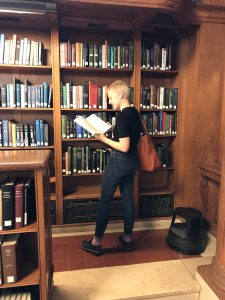On December 10, 2016, the phrase “fake news” was first tweeted by @realDonaldTrump:
“Reports by @CNN that I will be working on The Apprentice during my Presidency, even part time, are ridiculous & untrue – FAKE NEWS!”
While emblematic of the recent presidential election and the present political climate at large, Trump’s decrial of the fake news media is hardly a new phenomenon. Rumors, mistruths, and propaganda have persisted since long before Twitter was invented. “Fake news” has functioned historically as a powerful mechanism of oppression and resistance alike, adopting different meanings and consequences for each group that participates in its circulation.
Taking its starting point at the present political moment and working backward, our project culminated in the collection of 100 historical case studies, each detailing the story of a rumor and its aftermath. For example, one case study examined the role of rumors in the Velvet Revolution:
The Czechoslovakian revolution—dubbed the Velvet Revolution—began with a rumor. A mass of thousands of Czechs marching culminated in violence after a lie was spread that claimed that Martin Smid, a 19-year-old college student, had been beaten to death by the police. The revolution ended in the Czechoslovakian regime’s collapse, but the rumor itself had been spread by a journalist and dissident named Jan Urban, who called it a “professional blunder.”
Further case studies attended to medical rumors, such as urban legends surrounding the AIDS crisis, while others examined the rumors that multiply exponentially following moments of political upheaval. The very first case study we recorded this summer, circa 411 AD, focused on a story of a Greek barber who was too easily fooled by a local rumor, which then was recanted as a moral lesson by the philosopher Plutarch.
The formatting of the 100 historical case studies was modeled largely after Tamotsu Shibutani’s seminal work, Improvised News, a fundamental text on rumor studies which examines a number of historical rumors through sociological theory. Our case studies were further supplemented with psychological studies in order to more deeply understand the role of rumor in the human psyche. One, for instance, examined rumor transmission in preschoolers, while another discovered that young girls undergoing early puberty are disproportionately exposed to rumors of higher frequency and intensity than their peers. Allport & Postman, likewise, established the Basic Law of Rumor, a formula by which rumor transmission can be modeled (for the curious: Rumor spread = Importance x Ambiguity).
Of critical importance to our project were recurring visits to libraries in New York City to conduct archival research. At the hallowed New York Public Library, Rebecca Federman, a Vassar alum and Research Coordinator, assisted us in the fundamentals of historical research. During a later visit to the Schomburg Center for Research in Black Culture, we accessed the library archives and pored over the George Marshall papers, which included newspaper reports on rumors that culminated in violence and lynchings in America from 1933-1955.
By tracking the lifespan of 100 historical rumors, we became more acutely aware over the course of our two-month project of the myriad ways that lies, rumors, and more specifically, fake news, become accepted as fact. Professor Kumar intends to release the results of the project in a forthcoming book, and I hope to pursue our research in a senior thesis in English—I was particularly struck by a case study on the literature of pseudoscience. This project was my first real step into conducting independent, long-term academic research, and I was relieved to discover that this is work I thoroughly enjoy and could spend a lifetime doing.
Citations
Bilefsky, Dan. “A rumor that set off the Velvet Revolution.” International Herald Tribune, 18 Nov. 2009. Infotrac
Bordia, Prashant and DiFonzo, Nicholas. “When social psychology became less social: Prasad and the history of rumor research.” Asian Journal of Social Psychology (2002) 5: 49–61
Principe, Gabrielle F. et al. “How Rumors Can Engender False Memories in Preschoolers.” Psychological Silence, Vol. 17, No. 3 (Mar., 2006), pp. 243-248.
Shibutani, T. Improvised News: a Sociological Study of Rumor. 1966. Bobbs-Merrill, Indianapolis, IN.

